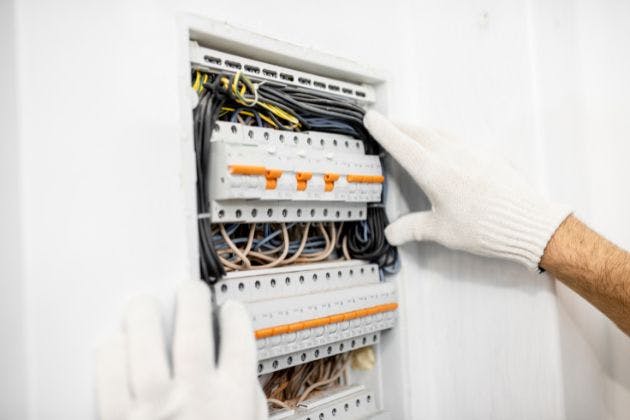Maintaining high-quality electrical systems may help you avoid accidents, fires, and other risks. Electrical Installation Condition Reports (EICRs) are a highly effective method of ensuring electrical safety. These reports play a critical role in identifying possible electrical dangers and maintaining your safety.
For more information on EICRs, speak with our electricians in New Romney, Folkestone, Hythe and Kent by calling us on 07971 857475.

What is an EICR Inspection?
An Electrical Installation Condition Report (EICR) is a formal document that is produced following an assessment of the electrical installation within a property. This report is carried out by a qualified electrician or an approved contractor.
Most Common Electrical Hazards Identified by EICRs
Overhead Power Lines
Overhead power lines carry dangerously high voltages capable of causing severe burns and fatal electrocution to workers. To mitigate these risks, maintaining a minimum distance of 10 feet from these power lines and any nearby equipment is crucial. Regular site surveys should be conducted to ensure that no objects are stored beneath overhead power lines. Additionally, installing safety barriers and warning signs can effectively alert non-electrical workers to the hazards in the area.
Damaged Tools and Equipment
Using damaged electrical tools and equipment can pose significant dangers, including shocks and fires. Only qualified personnel should handle repairs. It's essential to thoroughly inspect cables, wires, and cords for any cracks, cuts, or abrasions. Any defects must be promptly repaired or replaced.
Inadequate Wiring and Overloaded Circuits
Using wires of incorrect sizes for the current can lead to overheating and potential fires. It's crucial to select the correct wire size suitable for the specific operation and electrical load. Employing appropriate heavy-duty extension cords and avoiding the overloading of outlets are essential practices. Regular fire risk assessments help identify areas at risk of faulty wiring and overloaded circuits, preventing dangerous situations.
Exposed Electrical Parts
Exposed electrical parts, such as temporary lighting, open power distribution units, and detached insulation on electrical cords, pose serious risks of shocks and burns. Implementing proper guarding mechanisms and promptly repairing any exposed parts are critical steps in mitigating these hazards and ensuring a safer working environment.
Improper Grounding
Improper grounding of equipment is one of the most frequent electrical violations. Proper grounding eliminates unwanted voltage and reduces the risk of electrocution. Never remove the metallic ground pin, as it is crucial for returning unwanted voltage to the ground. Ensuring all equipment is adequately grounded is vital for safety.
Damaged Insulation
Defective or inadequate insulation is a significant electrical hazard. It's important to identify damaged insulation and report it immediately. Before replacing damaged insulation, all power sources should be turned off to prevent accidents. Avoid attempting to cover the damaged area with electrical tape, as it is not a reliable solution.
Contact our electricians in Kent
We offer reliable EICR inspections in Folkestone, Hythe, New Romney and the surrounding areas. Contact us at 07971 857475 or via email at help@inspiredsmartliving.com to schedule a service.


